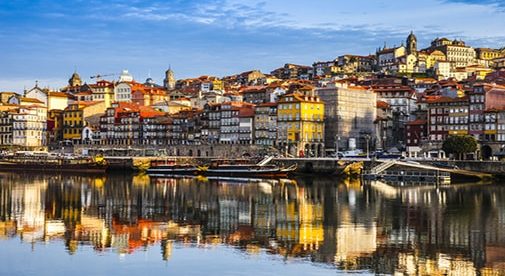While most digital nomads will make Lisbon their first stop on their Portuguese tour, they would be wise to dedicate at least as much time to its northerly neighbor, and Portugal‘s second-largest city, Porto.
Porto is a living, breathing picture-postcard of European charm, with plenty to see and do. There’s a proverbial banquet of exciting activities, from historic city walks to wine tastings across the river in Vila Nova de Gaia’s wine caves. But best of all, as such a low-cost city, it never feels like you’re reaching into your pocket, which makes it perfect for anyone looking for a remote working base.
Where to Park Your Laptop in Porto
Porto has a number of appealing neighborhoods, offering a variety of lodgings to match any length of stay, budget preferences, and travel lifestyle.
From each central neighborhood, you can easily walk to the city’s bustling downtown area overflowing with buzzing outdoor cafés, stunning scenic views over the Douro River, and lively bars. Just about anywhere you set up a workspace, there’s opportunity for fun work breaks, whether strolling the river-bank, walking winding cobblestone streets in the old town districts, or grabbing a picnic lunch while you laze in a nearby public park to watch the Douro’s rabelo boats or the cable car high above the wine caves.
Ribeira
A UNESCO World Heritage site, the colorful Ribeira neighborhood weaves through narrow, steep, and winding cobblestone streets before opening into Porto’s heartbeat, the lively café-rimmed riverside promenade shouldering the majestic Douro River.
From here, you have a front row view of the towering Dom Luís I Bridge connecting Porto to Vila da Gaia across the river, where you’ll find the Port wine cellars. Ribeira is also popular for people-watching and for gazing at picturesque vintage boats as they glide by, headed out on a scenic Douro Valley cruise, nestled between scores of vineyards scaling the steep hillsides.
The Ribeira area is certainly center stage for much of Porto’s charm, ambiance, and energy. Colorful buildings line the riverbank, dotted with lively cafés and bars as far as the eye can see. I never tired of gazing at the river, glass of Douro wine in hand, watching both small and large boats meander the river.
For sightseeing in Ribeira, go see Porto’s fortified Romanesque cathedral, known as the Se. The imposing cathedral looms over Ribeira’s surrounding medieval alleys, such as the Rua das Flores, where you’ll find the Museu da Misericórdia do Porto, Bolsa Palace, and the Monument Church of St Francis.
Boavista
If you prefer a laidback lifestyle with fewer tourists, you can choose to stay in a low-key neighborhood like Boavista. Running through the area is the Boavista Avenue, which is Porto’s longest boulevard and one of its most beautiful—with large designer houses, villas, botanical gardens, and upscale hotels and condo-hotels. Here, you’ll find a more tranquil atmosphere and are only minutes away from downtown by bus or metro.
If you take one of the hop on/hop off bus routes, you’ll be on the Boavista Avenue all the way to the ocean, where sits Forte de São Francisco Xavier, just minutes from the Foz do Douro, Matoshinos village, and Porto’s ocean port. For sightseeing in Boavista, tour the famous Casa da Musica, where evening concerts are held, and enjoy a walk around the many lakes in beautiful Jardim Botanical do Porto.
Aliados & Bolhao
This area was one of my favorites for just chilling and exploring iconic historic sights nearby. The vibrant neighborhood is just beyond the Ribeira, adorned with spacious bustling plazas rimmed by restaurants and tourist kiosks.
Both the central bus station (Praca da Liberdade) and the train station (Praca Almeida Garrett) sit right in the middle of the neighborhood (Praca da Liberdade), providing easy access. Mere blocks away is the famous boulevard, rua da Santa Catarina, bursting with shops, cafés (like the famous Café Majestic), and traditional churches covered in azulejos (blue and white hand-painted tiles).
Brimming with old-school shops and baroque churches along the backstreets, there are also plenty of speakeasy-style bars and outdoor live music venues after dark.
For sightseeing in Alidos & Bolhao, explore the soaring Torre de Clerigos for panoramic city and river views, and Carmelite Churches (Igreja do Carmo and Igreja dos Carmelitas), with a three-foot-wide 17th-sentury house separating the two churches.
Vila Nova De Gaia
Some digital nomads and expats prefer the quiet, laidback Vila Nova De Gaia area, which is just across the Dom Luis I Bridge. It’s more suburban and tranquil, yet has easy access to all of Porto’s activities and attractions, just a short walk or tram ride across the river.
Another draw to the area is its low-cost. While Porto is quite affordable, Vila Nova De Gaia is even more so, and has less tourists.
For sightseeing in Vila Nova De Gaia, feast your eyes on all the wine houses lining that side of the River Douro. Then stroll into any of them for wine tasting and to learn about wine making (I enjoyed a visit at the Porto Calem). You can even take a cable car (Teleferico de Gaia) soaring over the river. Another popular attraction is to visit the hilltop-perched Mosteiro da Serra do Pilar for the great views across the river.
Related Articles
The Perks Of Working Remotely From Portugal
Working As A Digital Nomad In Lisbon, Portugal
5 Reasons To Get Yourself To Europe’s Remote Working Capital
Upcoming Conferences
The Only 2024 Fast Track Panama Conference
If your dream retirement involves stunning beaches… lush green mountains… a warm climate with no hurricanes… first-rate healthcare… incredible value for money (a couple can live well on $2,200 a month)… and the World’s #1 Retiree Discount Program…
Join our Panama experts and expats in February and discover why Panama could be your perfect paradise.


.png)